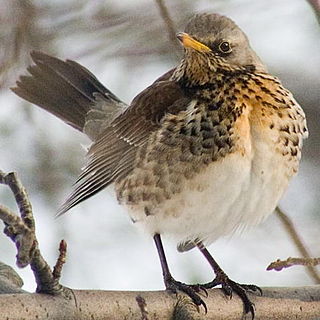
The fieldfare is a member of the thrush family Turdidae. It breeds in woodland and scrub in northern Europe and Asia. It is strongly migratory, with many northern birds moving south during the winter. It is a very rare breeder in the British Isles, but winters in large numbers in the United Kingdom, Southern Europe, North Africa and the Middle East. It is omnivorous, eating a wide range of molluscs, insects and earthworms in the summer, and berries, grain and seeds in the winter.
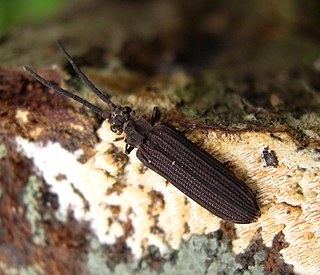
The Cupedidae are a small family of beetles, notable for the square pattern of "windows" on their elytra, which give the family their common name of reticulated beetles.

Sanguine is a stain, or non-standard tincture in heraldry, of a blood-red colour. In the past it was sometimes taken to be equivalent to murrey, but they are now considered two distinct tinctures. It is a brownish red, the colour of arterial blood.
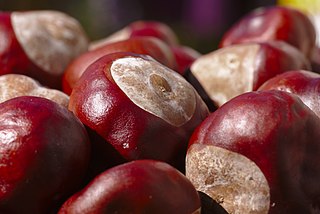
Maroon is a dark reddish purple or dark brownish red color that takes its name from the French word marron, or chestnut.

In photography, toning is a method of changing the color of black-and-white photographs. In analog photography, it is a chemical process carried out on silver-based photographic prints. This darkroom process cannot be performed with a color photograph. The effects of this process can be emulated with software in digital photography. There is debate whether a toned black-and-white photograph should be considered to still be black-and-white, as simply being monochromatic is not a sufficient condition for an image to count as black-and-white.
Taupe is a dark brown color between brown and gray. The word derives from the French noun taupe meaning "mole". The name originally referred only to the average color of the French mole, but beginning in the 1940s, its usage expanded to encompass a wider range of shades.
Auburn hair is a variety of red hair, most commonly described as reddish-brown in color or dark ginger. Auburn hair ranges in shades from medium to dark. It can be found with a wide array of skin tones and eye colors, but as is the case with most red hair, it is commonly associated with light skin features. The chemical pigments that cause the coloration of auburn hair are frequently pheomelanin with high levels of eumelanin; however, the auburn hair is due to a mutated melanocortin 1 receptor gene in the people of Northwestern European descent and by a mutated TYRP1 gene in the Austronesians, both genes that reduce the melanin production of the hair cells.

The shovel-billed kookaburra, also known as the shovel-billed kingfisher, is a large, approximately 33 cm (13 in) long, dark brown tree kingfisher with a heavy, short and broad bill that is unique among the kingfishers. It has a dark head with rufous stripe behind eye, a white throat, rufous neck collar and underparts, bright blue rump, brown iris, brownish-black bill with paler mandible and pale feet. Both sexes are similar in appearance, but are easily recognized from the color of the tail. The male has a dark bluish tail while female's is rufous. The juvenile has a female-like plumage with scale-patterned feathers.

The Hainan hare is a species of hare endemic to Hainan Island, China.
Amanita orientifulva, also known as the Asian orange-brown ringless Amanita, is a species of agaric fungus found at altitudes ranging from 1,300–4,200 m (4,300–13,800 ft) in southwestern China. It is associated with trees, especially Abies, Quercus, Salix, and occasionally Castanopsis. It fruits singly or scattered from June to September.
The saddled swellshark is a rare species of catshark, and part of the family Scyliorhinidae, endemic to Eastern Australia. This bottom-dwelling species is found on the outer continental shelf and upper continental slope at a depth of 115–605 m (377–1,985 ft). It is a robustly built shark with a short, broad, flattened head and a capacious mouth. Adults are patterned with saddles on a brownish or grayish background, which varies between tropical and temperate sharks; juveniles are light-colored with many spots. This shark reaches 74 cm (29 in) in length. Like other swellsharks, it can inflate itself as a defensive measure. Reproduction is oviparous.
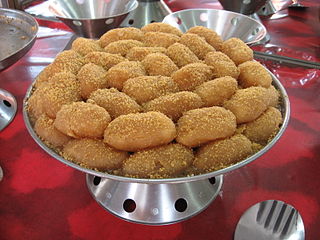
Chomchom, cham cham, or chum chum is a traditional Bengali sweet, popular throughout the Indian subcontinent. The cuisine comes in a variety of colors, mainly light pink, light yellow, and white. It is coated with coconut or mawa flakes as a garnish.
Psilocybe graveolens is an extremely rare psilocybin mushroom which has psilocybin and psilocin as main active compounds, discovered in the salt marshes or "meadows" of Hackensack, New Jersey. This mushroom is known for its strong and persistent odor.
Psilocybe liniformans var. americana, is a psilocybin mushroom in the family Hymenogastraceae. It is in the section Semilanceatae of Psilocybe and has psilocybin as its main active compound.

Gymnopilus luteus also called the "Yellow Gymnopilus" is a widely distributed mushroom of the Eastern United States, it contains the hallucinogens psilocybin and psilocin. Often mistaken for Gymnopilus junonius.
Rufous is a colour that may be described as reddish-brown or brownish-red, as of rust or oxidised iron. The first recorded use of rufous as a colour name in English was in 1782. However, the colour is also recorded earlier in 1527 as a diagnostic urine colour.
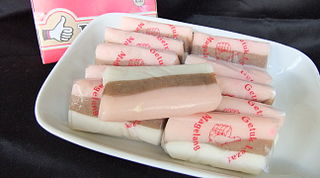
Gethuk is a Javanese dish made from cassava. The cassava is peeled, boiled and mashed. Then it is mixed with grated coconut, sugar and small amounts of salt. Sugar can also be substituted with palm sugar to give it brownish color and more distinctive taste.
The New Albany Shale is an organic-rich geologic formation of Devonian and Mississippian age in the Illinois Basin of the United States. It is a major source of hydrocarbons.

Titian is a tint of red hair, most commonly described as brownish-orange in color. It is often confused with Venetian and auburn.
Crocidura kegoensis, also known as the Ke Go shrew or Ke Go white-toothed shrew, is a species of shrew in the genus Crocidura described in 2004. It is smaller than other Crocidura species known from Vietnam, brownish-grey in colour with black markings on the muzzle. Its hair is short. The holotype was found in the Ke Go Nature Reserve, in Vietnam's Ha Tinh province, at an altitude of about 200 m.














